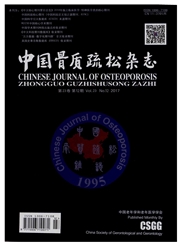

 中文摘要:
中文摘要:
目的:探讨椎体固化(PVP)治疗骨质疏松性Kümmell病的手术适应证,评价PVP在骨质疏松性Kümmell病中的疗效。方法:2009年3月至2011年3月56例骨质疏松性Kümmell病患者,其中男17例,女39例,平均62.8岁。术前CT测量“真空样”改变的体积、位置;椎体椎弓根轴线与椎弓根骨性穿刺点与椎体“真空样”改变处连线的夹角,确定穿刺方向。术前、术后3d及末次随访时采用VAS评分评价疼痛情况,应用x线片评价骨水泥以及骨折椎体情况。结果:随访15~37个月,平均25.4个月,骨水泥位置良好,病变椎体无再骨折,骨水泥与椎体界而无透亮区。VAS评分术前(7.6±0.8)、术后3d(2.3±0.6),差异有统计学意义(P〈O.05);末次随访时(2.2±0.5),与术前比较差异有统计学意义(P〈O.01)。结论:PVP技术治疗骨质疏松性Kümmell病快速、安全、可靠。确定责任椎体以利于适应证的选择,准确的影像学测量有利于穿刺的准确性。
 英文摘要:
英文摘要:
Objective: To investigate the indications of vertebral body solidification (pereutaneous vertebro- plasty, PVP) in treatment of osteoporotic vertebral compression fracture (osteoporotie Kümmell's disease) and evaluate its effect. Methods: From March 2009 to March 2011, 56 patients with osteoporotie Kümmell's dis- ease (including 17 male and 39 female, aged between 55 and 72 years) underwent posterior unilateral PVP. The size and location of vacuum change, and the angle between vertebral body pediele axis and pedicle bone puncture point to vertebral vacuum change line, were measured preoperatively by CT scan, to deter- mine the puncture direction. The pain was evaluated by VAS score, and the condition of fractured vertebral body and bone cement were observed by X-ray films before operation, 3 days after operation and last fol- low-up visit. Results: All cases were followed-up for 15-37 months (mean 25.4 months), position of bone cement was good and affected vertebral body not refractured. There was no lucent area noted between bone cement and vertebral body interface. VAS score was 7.6±0.8, 2.3±0.6 and 2.2±0.5 before operation, 3 days after operation and last follow-up visit, respectively, with a significant difference between before and 3 days after operation (P〈0.05), and last follow-up visit (P〈0.01). Conclusion: PVP for treatment of patients with osteoporosis Kümmell disease is fast, safe and reliable. Determination of the responsibility vertebral body is good for the choice of indications and accurate imaging measure profit exact puncture.
 同期刊论文项目
同期刊论文项目
 同项目期刊论文
同项目期刊论文
 期刊信息
期刊信息
